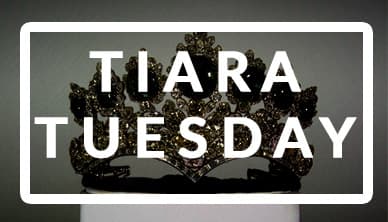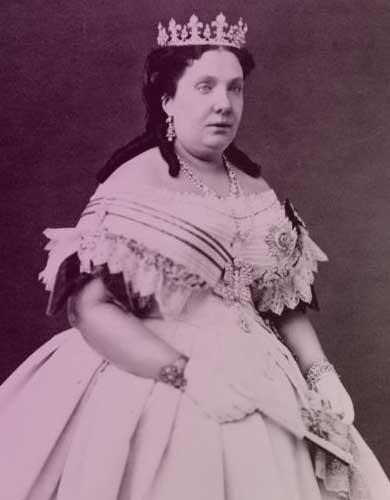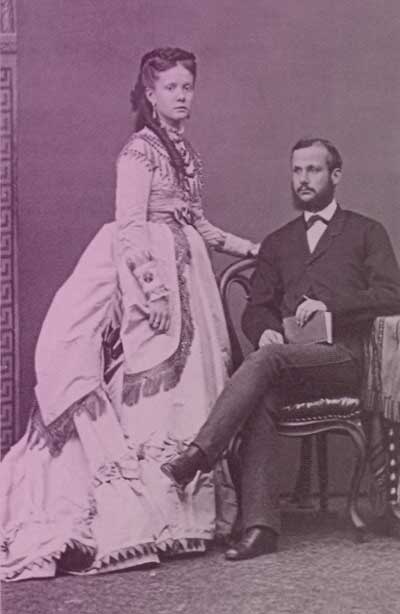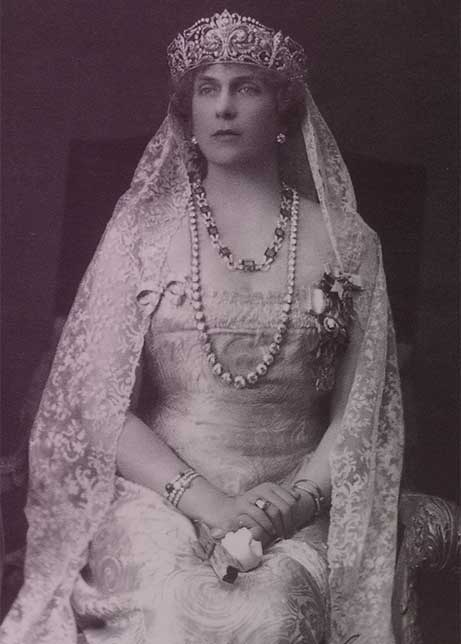Share this Post
Ordered by Queen Isabel II of Spain in 1868, the Mellerio shell tiara was a wedding present for Isabel’s oldest daughter, also (creatively) named Isabel.
It features pearl and diamond shell motifs with pear-shaped pearls hanging at the center of each shell. Each shell also curls forward like a wave about to break, which I’d imagine creates some interesting sparkle if you’re under good lighting. That diamond hanging from the bottom is also detachable, in case you don’t have puffy hair and don’t want a diamond hanging on your forehead. Here it is on Queen Sofia:
The Reign in Spain Falls Mainly on the Plain
Isabel’s reign had been rough going so far. She was the oldest daughter of a king who attempted to ditch the Salic Law, which said a woman couldn’t inherit the throne. Her father, Ferdinand VII, introduced a new law that said hell yes, my oldest daughter can inherit this shit. That didn’t go over too well with Ferdinand’s brother, Carlos, who would have been heir under the Salic Law.
When Ferdinand died, Isabel was only three years old. Carlos launched an all-out assault to try and win the crown. For seven long years, Carlos fought Isabel and her mother, who acted as regent. The army supported Isabel and her mother, and kept Carlos at bay as best they could. Finally, at age 13, they’d held on long enough to have Isabel legally declared queen, fit to rule by herself. I don’t know about you, but at age 13, I was barely fit to dress myself, let alone rule a country, but hey, different strokes for different folks.
I don’t know about you, but at age 13, I was barely fit to dress myself, let alone rule a country, but hey, different strokes for different folks.
Maybe someday I’ll show you guys the evidence of my bad fashion and hair choices of the time, but today is not that day.
Back to Isabel.
The problem with being a queen is that everyone just wants you to get married and have kids. If you’re young and vulnerable, like Isabel, this problem gets magnified by a factor of 10. The government basically forced her to get married in a bid to secure the crown. At the age of 16, she married her cousin, Francisco do Borbon. Isabel and Francisco had 12 kids, 7 of whom died as children. Court gossip claimed Francisco was gay and some, if not all, of Isabel’s kids were fathered by other men. Isabel wasn’t exactly a looker, and then as now, this made her a target for gossip. Here’s how an Englishman described her:
“The Queen is large in stature…There is no dignity either in her face or figure, and the graces of majesty are altogether wanting. The countenance is cold and expressionless, with traces of an unchastened, unrefined, and impulsive character, and the indifference it betrays is not redeemed by any regularity or beauty of feature.”
Ouch.
You can decide for yourself if he was right.
La Chata
Isabel hung on through 25 years of gossip, infighting, and intrigue. The country was a disaster as a result, because everyone who could do nifty things like modernize the country were too busy infighting and clinging to their shreds of personal power – dignity had long since been abandoned.
When the time came for Isabel’s oldest daughter, Isabel, to marry, the queen ordered this tiara as a wedding present for her. Isabel the younger, called “La Chata,” was to marry Prince Gaëtan of Bourbon-Two Sicilies – a penniless relation forced on La Chata in retribution for her mother’s acknowledging the newly unified kingdom of Italy. “La chata” is a form of endearment based on the recipient having a flat nose. I think she was adorable. Click here to see her picture and check her out with her husband below:
La Chata’s wedding would be the last royal event before a revolution brought Isabel and her family down.
In 1868, two generals decided they’d had enough and attacked Isabel’s forces. Isabel’s generals pretended to care, but mostly, everyone just wanted something, anything, to change. Isabel fled, seeking refuge in Paris.
La Chata and her husband were on their honeymoon at the time; Gaëtan hurried back to fight on Isabel’s behalf, but it was all for nothing. Isabel’s forces were defeated, and La Chata and her husband settled in Paris with the exiled queen. Gaëtan sank into depression, and lost the willpower to keep a secret he’d been desperate to hide: he was epileptic. La Chata only found out when he had an attack in front of her.
Gaëtan sank into depression, and lost the willpower to keep a secret he’d been desperate to hide: he was epileptic.
Not long afterward, in 1871, La Chata had a miscarriage. Gaëtan sank into a deep depression—no country, no crown, no baby, and now everyone knew he was seriously ill.
It was too much for him. He tried to jump out a window in late 1871, after which La Chata and her household staff tried never to leave him alone. In December of 1871, while they were visiting relatives in Switzerland, Gaëtan locked himself in a room and shot himself in the head.
La Chata never remarried.
Bills, Bills, Bills
Okay, now we need to back up a bit. While all this was happening to La Chata, Isabel was adjusting to life in exile in Paris. One day, she went to get the mail and found a big surprise – the bill for a bunch of jewelry she hadn’t paid for yet, including this tiara. People in exile don’t tend to have 161,000 francs just lying around, and Isabel was no exception. She pretended that shit got lost in the mail.
People in exile don’t tend to have 161,000 francs just lying around, and Isabel was no exception. She pretended that shit got lost in the mail.
But the jeweler, Mellerio, needed to get paid. They sent a lawyer straight to Isabel’s house. At that point, there was nothing for Isabel to do but have her lawyers start negotiating. She offered a compromise – she’d give them 20,000 francs for the jewelry she’d purchased since going into exile, but she refused to pay a dime for anything she bought while she was the reigning queen of Spain.
This did not make the jewelers happy. They sued her ass and began a legal battle that took years to conclude. In the end, being a queen can’t save you from an unpaid bill. The courts ordered Isabel to suck it up and pay for what she’d ordered, all 161,000 francs of it.
What Happened to Spain?
Remember how much of a disaster Spain was during Isabel’s reign? Well, those problems didn’t just go away because she wasn’t there. The republic that displaced her couldn’t solve the problem of infighting and power-mongering, and as a result, it only lasted a few years. It fell apart in 1874 and Isabel’s son, Alfonso, was reinstated as king. But poor Alfonso died at the young age of 27 in 1885, and his unborn son became King Alfonso XIII the minute he was born.
La Chata, the owner of this tiara, had moved back to Spain when the monarchy was restored. She helped raise her younger siblings and her brother’s children, and died childless in 1931. She left the tiara to her nephew, King Alfonso XIII. This Alfonso married a granddaughter of Queen Victoria, Victoria Eugenie, called “Ena.” On their wedding day, a terrorist advocating for Catalan independence threw a bomb. It missed Alfonso and Ena, but it killed some of their guests and bystanders. Great way to start a marriage, right?
On their wedding day, a terrorist advocating for Catalan independence threw a bomb. It missed Alfonso and Ena, but it killed some of their guests and bystanders. Great way to start a marriage, right?
Like a goddamn Swiss clock, tragedy struck again. Victoria Eugenie was a carrier for hemophilia, just like Princess Alix of Hesse, who transmitted the disease to her son, the Tsarevich of Russia. In 1907, Ena had a son, also named Alfonso. As soon as he was circumcised, the realized he had hemophilia. The couple’s youngest son, Gonzalo, also had hemophilia. Alfonso resented Ena for it for the rest of his life.
Here’s poor Ena, wearing her favorite fleur-de-lys tiara and a diamond necklace I’d kill to own:
As if all that shit weren’t bad enough, Alfonso and Ena also fell victim to a Spanish revolution. After a long and expensive war to try and preserve Spanish territory in Morocco, a Spanish general decided enough was enough. General Miguel Primo de Rivera enacted a coup and seized power. Oddly enough, he and Alfonso were able to work together to co-rule the country until 1930. But in 1931, Alfonso and Rivera lost their grip on the country. The army deserted them and Alfonso and Ena fled the country as the Second Spanish Republic was declared. For ten years, they dreamed of regaining their throne. It didn’t happen. In 1941, Alfonso abdicated in favor of his son, Juan, Count of Barcelona, and died in Rome six weeks later.
During their exile, Spain was plunged into the hell of civil war, from which General Franco emerged the winner. Franco refused to restore the monarchy, and one of his generals threw Juan out of the country.
What Happened to This Tiara?
Alfonso and Ena had given it to their daughter-in-law, Maria Mercedes of Bourbon-Two Sicilies. Maria Mercedes had married their son Juan and became the Countess of Barcelona. Like Ena, Maria Mercedes only wore the tiara once in public.
It basically sat around for 30 years until her son, Juan Carlos, chose Princess Sofia of Greece and Denmark as his bride. In 1962, the Count and Countess of Barcelona gave this tiara as a wedding present to Princess Sofia, who (I think) loved this tiara at first sight. She first wore it to the ball before her wedding. Click here to see the pic – it’s fantastic.
The tiara is now Sofia’s personal property, and she’s worn it a lot as Queen of Spain.
Wait, what? But wasn’t the Spanish royal family exiled? How did Sofia get to be queen?
General Franco, who’d taken power in 1939, chose Juan Carlos to be the next head of state. Franco thought Juan Carlos would be as right-wing and authoritative as he’d been. That was the idea, anyway, but it didn’t happen.
In 1975, after Franco died, Juan Carlos became King of Spain and the monarchy was officially restored. Juan Carlos transitioned the country from a dictatorship to a constitutional monarchy, which it remains today – although not without a few hiccups along the way. Juan Carlos abdicated in favor of his son in 2014, due to deteriorating health, bad press (son-in-law embezzling from the royal budget), and some bad personal decisions (illegitimate kids, repeat bear hunting that pissed off environmentalists). Felipe VI, his son, is now king, and Felipe’s hot wife, Queen Letizia, has worn the tiara at least once, although it remains the personal property of Sofia.
How Would I Wear It?
Okay, so I’m not fond of this whole shell design. It feels like cheesy performance art to me. But I do respect the way the family kept the tiara, never selling it when they ran into tough times. It obviously meant something to them. Still. Meaning or not, you can’t escape the whole she-sells-seashells-by-the-seashore vibe.
So I give in. I’m wearing this to a clambake on the beach. Not to some lame chain restaurant like Red Lobster or Long John Silver’s – no, I’ll give this tiara more respect than that. An all-night bonfire on the beach, eating fresh seafood, roasting some marshmallows, passing a flask to stay warm when the sun goes down. No, I won’t be planning revolution or fleeing from one. I’ll just be among good friends and good scenery, with a full belly and a happy heart, which sounds like a hell of a lot more than some of these poor ladies got out of life.
You guys, we really need to create a sea-inspired cocktail that we can name La Chata.
I think that would be appropriate. Chime in with your vote in the comments.
That’s the Mellerio shell tiara!
Want to suggest a tiara? Drop its name or a photo link into the comments. I’ll do my best to find something interesting in its history for a future Tiara Tuesday.

About the Author
I write non-fiction, fiction, and run the YouTube Channel The Girl in the Tiara. My first non-fiction book, The Hunt for Anna Pavlovna’s Stolen Jewels, will be published by Pen and Sword History in 2026. To keep in touch, sign up for my royal history newsletter here.
Image credits
La Chata wearing tiara (header image): Image by an unknown photographer, public domain via Wikimedia Commons
Isabel II: Image by an unknown photographer, public domain via Wikimedia Commons
La Chata and Gaëtan: Fratelli d’Alessandri, public domain via Wikimedia Commons
Ena: Image by an unknown photographer, public domain via Wikimedia Commons

Love Royalty and Tiaras?
You might like my other site, The Girl in the Tiara. I created it to write about amazing royal women and their tiaras. It’s like Drunk History meets The Crown.

Tiara Tuesday Archives
Visit the archives to read about more royal shenanigans. And by shenanigans, I mean war, revolution, betrayal, lust, murder, diamonds, and Princess Stéphanie’s chafing dish.
Tell the World



